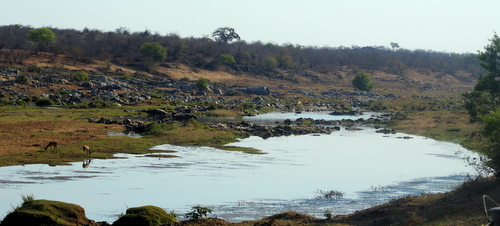
For me, there is always something spiritually cleansing about heading off in to the bush. You leave behind the worries, the strains, the irritations of day to day life, to embrace a sense of wonder and a buried instinct that reminds you that you are still one with nature.
That was certainly very much how I felt when I recently found myself, once again, driving through the gates at Punda Maria in northern Kruger.
I have come back to this spot numerous times and the enchantment never wanes, not only because of its beautiful bushveld setting but because of the promise it holds. There is always something new to discover.
Normally when I go to the bush I am focused on one main thing. It is all about looking for lifers and ticking as many birds off my list as possible.
This time it was slightly different. I was travelling with my sisters, Sally, an artist, and Penny, a social anthropologist, and we had a broader goal. We were hoping to not only to recharge our spiritual batteries but also find inspiration – in my case for a series of paintings I had planned.
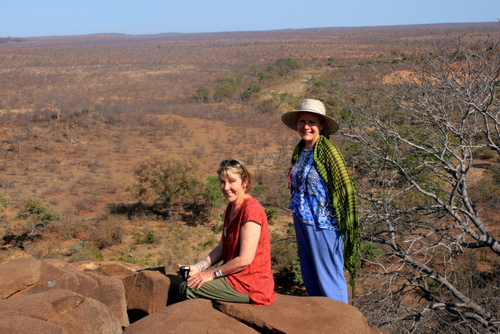
Any birds I saw would be an added bonus.
Our journey also differed from my normal ones in that we were doing it in much more style and luxury than I am accustomed to. Instead of having to sleep on the hard ground in my tiny tent, Penny had, as a special birthday treat for me, booked us in to hutted accommodation.
We spent our first two nights at Punda Maria with a day trip to Pafuri in between. I have described this area in a previous blog post so won’t repeat myself here.
Leaving Punda Maria, early on the second morning, we headed south towards Shingwedzi. As we drove the clouds came rolling ponderously towards us in never ending procession across an inimitable sky, although the sun never seemed to stop shining through them
About fifteen kilometres into our journey we came across a pride of lion, lying in a gully alongside the road. Languid and completely unconcerned by our presence, they exuded an air of arrogant authority.
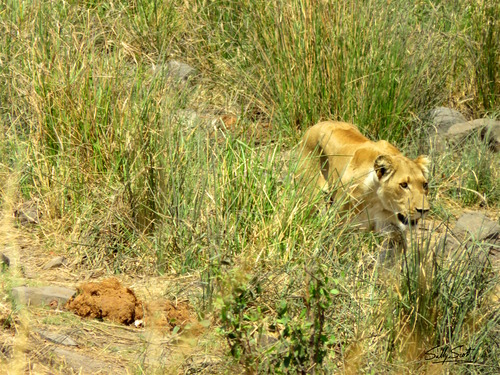
Looking at them, dozing in the shade, made me glad I am, not a buck or a zebra. With predators like them around there is no way you can ever exactly nod off. When a lion roars you can imagine shadowy herds freezing in the darkness.
Leaving the snoozing lions to their day-dreams we continued on our way.
Reaching a crossroads, we branched off the tar and on to the Phongolo Loop. It turned out to be a good move because the loop is, to my mind, one of the most rewarding drives in the whole of Kruger.
There was game – and birds – a plenty.
The tree-lined river, which the road follows, was mostly dry but every now and again there would be an isolated, mud-brown, pool.
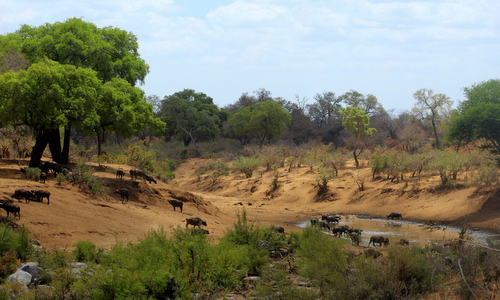
We stopped directly above one such pool. It had a steep-sided red-coloured cliff behind it. Down at the water’s edge lay a huge crocodile. With its hard, ugly, carbuncular skin and protruding eyes, it really did look like something from the early stages of creation.
Time and science may have removed much of our fear of the natural world but I still experience a slight tremor in my gut whenever I see these evil-looking reptiles…
As we sat, in the safety of our car, watching this one, a small group of waterbuck came loping down the steep side of the gully. They drew up short when the lead male spotted the crocodile lying in the shallows. Strangely, the waterbuck seemed more curious than afraid, tentatively moving down to the water’s edge to examine the beast.
I kept waiting for the inevitable but it never happened. The crocodile continued to lie motionless and eventually the waterbuck lost interest and moved off.
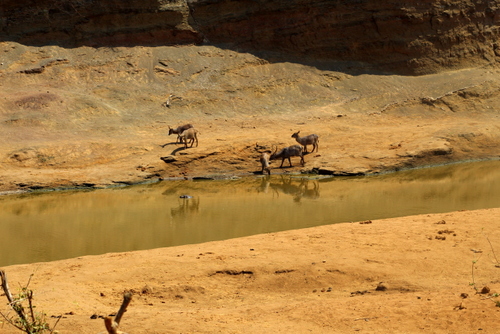
I was told afterwards – I have no idea how true this is – that waterbuck have a special gland, the odour from which repels crocodiles.
Back on the road we saw more elephant and several big herds of buffalo. We also came across a pair of Kori Bustard resting in the shade. The undoubted highlight was, however, a young leopard, walking down the dry, sandy river bed, swishing its tail as it went.
Getting to our nights accommodation at Bataleur Bushveld Camp proved to be no easy task. As we trekked up the dirt road bunches of elephant kept trundling across it, on the way to their watering holes. Often we had to brake and wait for them to pass.
It is a strange thing when you think you are doing the looking, to find yourself being observed. Especially when the one doing the observing towers above you and doesn’t look exactly pleased to have you around. We had a few gulp moments…
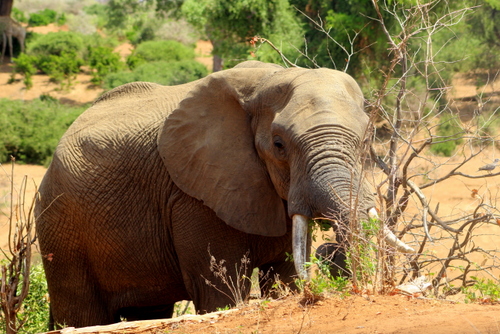
Petra, a friend of Penny and Sally, who was due to join us later, had even worse luck and was forced to turn around because of the elephant and take a much longer route eventually arriving at Bataleur just as they were shutting the entrance gates.
Bataleur is situated in thick, dry, riverine bush that stood waiting, expectantly, to be transformed by the arrival of the rains, still probably some months off.
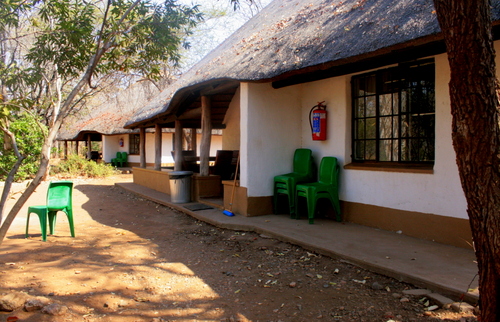
It, too, was alive with birds. There were some very tame hornbills (Red-billed, Yellow-billed and Grey), Crested Francolin, Go-Away Birds, Arrow-marked Babblers and African Mourning Doves. Also a very noisy party of screeching, acrobatic, Brown-headed Parrots feeding in a nearby wild-fruit tree
As the sun dipped behind the trees we were paid separate visits by South Africa’s two tiniest owls – first the Pearl-spotted Owlet and then the African Scops-Owl. Landing in a tree outside our chalet, the Scops immediately started signalling to all the other owls in the area with its soft, frog-like, “Prrrupp”.
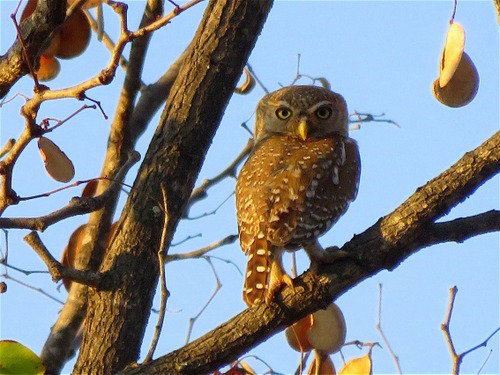
It was much hotter the following morning as we set off for our final destination, the Shimuwini Bush camp. Ahead of us lay miles and miles of more stunted mopani scrub, all bony trunks and sparse, spindly branches.
We stopped near a water point, where several elephant were siphoning water out of the top of a reservoir. There was also a solitary hyena, skulking around, like he was carrying some sort of guilty secret. When a nearby herd of zebra spotted it, they immediately charged, kicking up great clouds of dust behind them.
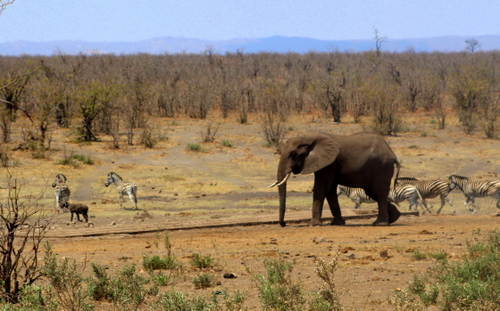
Caught unaware, the hyena did not need any prompting – it turned tail and fled with the zebra in hot haste behind.
Once they had sent the shame-faced animal scuttling off in to the surrounding bush the zebra halted, fanning out in to a half crescent-shaped phalanx, like a Zulu impi, to prevent it from returning. The hyena took the hint and did not return.
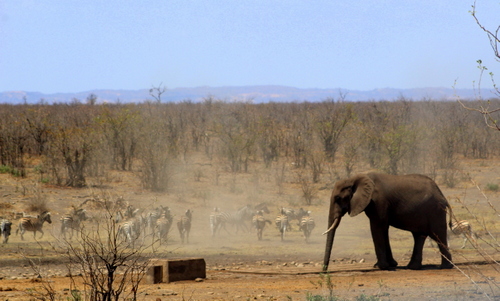
Shimuwini, when we got there, was a revelation. Situated on the banks of the Letaba, it seemed miles from anywhere. Across the river rolled plains seemingly endless, shimmering with heat, barren of landmarks save for the occasional baobab and small rocky outcrops. There seemed to be a presence here, a spirit, an atmosphere that had nothing to do with man. We were mere transitory callers, passing through.
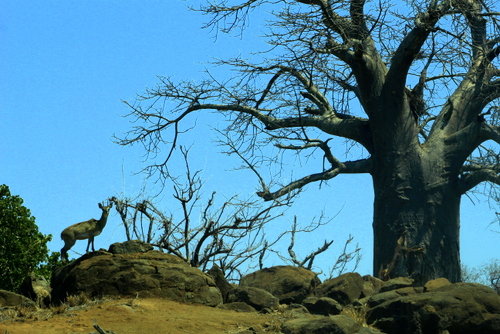
At this time of the year the Letaba provides one of the few sources of water in an arid land so you didn’t really have to go anywhere to look for game – you just need to sit out on a chair under the spreading trees, drink in hand, and wait for it to come to you. Immediately in front of us, in a large pool, a pod of hippo kept rising up, snorting out columns of bubbles and steam and then disappearing again, leaving behind a mass of ever-widening ripples on the waters surface.
Several crocodiles lay silently in shallow inlets, only their nostrils showing. On the opposite bank a steady stream of animals kept coming down to drink.
There were lots of water birds, including Fish Eagle, Saddle-billed Stork, Openbill Stork, Yellow-billed Stork, Egyptian Geese, White-faced Fulvous Whistling Duck, African Jacana, Water Dikkop and Black Crake.
As we sat watching them, the dusk seemed to creep up from the ground like a stalking animal. The whole sight before us was one of almost religious beauty, stirring to both the spirit and the eye.
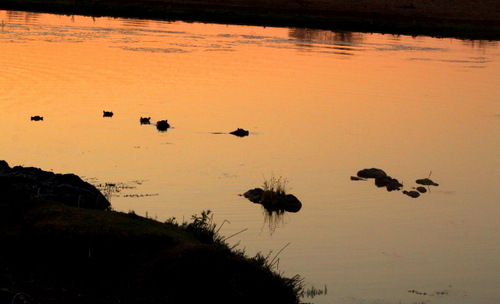
I like to think that it is to some such place my soul might return at the end of life.
As bewitching as it all was I eventually had to pull myself away to fulfil my allotted role as braai-master. After a delicious fillet steak and several glasses of red wine, which we consumed sitting on the verandah under a star-spattered sky, we retired to bed.
And then it was dawn; the sky turned red and apricot and orange and smoke-grey beyond the river. Light came flooding back in to the world.
Penny surprised us all by being the first one up, followed by Sally who wandered down to the water’s edge, cup of tea in hand, to watch the sun rise. Once it had lifted itself above the horizon, she decided to make the most of the time we had left and set off on a walk around the perimeter fence of the camp, taking lots of photographs as she went. Near its outer edges she heard lion grunting in the distance.
Driving in, on the previous day, we had seen an eddy of vultures, black specks circling high in the sky over what was presumably a fresh kill, which gave us some idea of what they had been up to.
I was reluctant to leave Shimuwini but we had only booked in for one night and were due to exit the park that day. As if picking up on my mood a small family of Dwarf Mongoose came scampering on to the lawn in front of us, stopping every now and again to sit upright on their haunches as if to say farewell. A pair of Red-headed Weavers landed in a nearby mopani tree and immediately started chasing each other all over it.
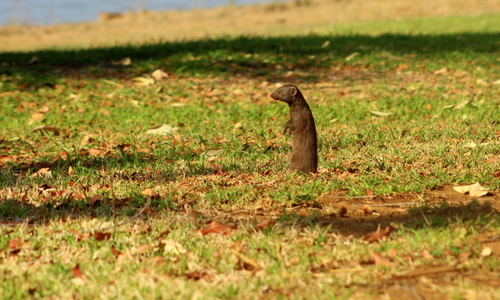
After breakfast we set off once more over the flat and now familiar country. Having driven what seemed like a fair distance we came around a corner and there was the Letaba again, flowing sedately east between low banks and a flutter of reeds.
Stopping in the middle of the low-level bridge we were rewarded with a scene as unexpected as it was arresting – a magnificent Martial Eagle, one of the largest of all the African eagles (there numbers now, sadly, dwindling) standing, on one leg, in the middle of the river. It seemed quite happy to pose for photos and it was still there, still standing on one leg, when we finally drove off.
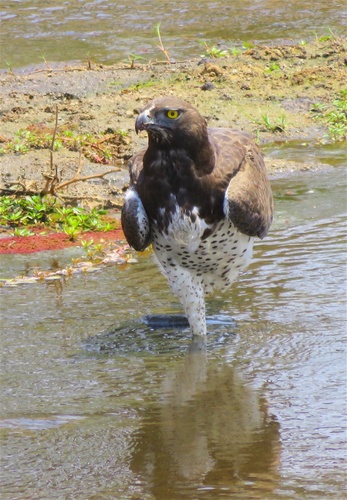
This was still perfect elephant country and we kept passing little groups of them especially where there was water. As we drove on, small maelstroms of dust and grass and dead leaves kept twirling up in to the hot sky around us. It was dust devil season.
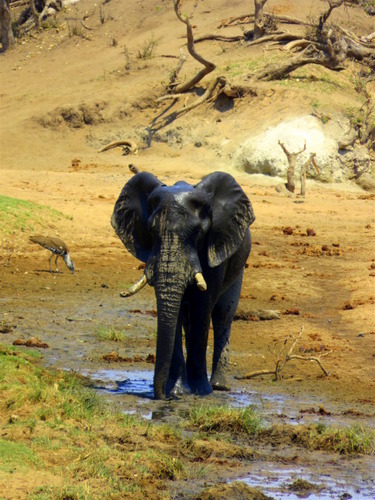
Some faraway hills broke the flatness. We had been told there was an ancient smelting site at one of them so we decided to follow a short-cut 4X4 track that led directly towards it.
We had only travelled a short way down the rough road when another large elephant stepped out from behind some trees and started ambling down the road behind us, like it had been especially tasked to make sure we quit the park.
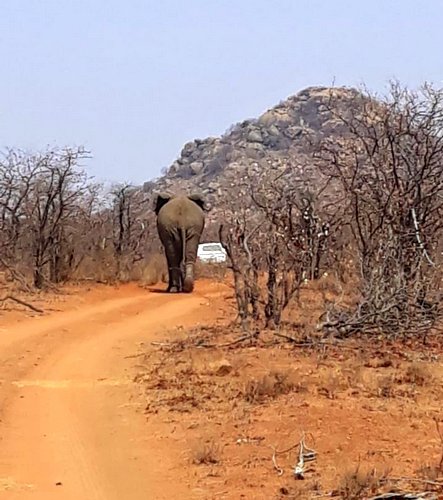
We took the hint. After a quick stop off at the Masorini Archaeological Site, which dates back to the Iron Age, we headed out the gate, through the ugly sprawl of Phalaborwa, with its smoke stacks, enormous dumps and tacky tourist shops.
The air felt oppressively hot. It was hard to believe that in a few days time I would be back in the green, cold, mist and drizzle of Curry’s Post.
FOOTNOTE: Besides seeing lots of birds and animals the expedition suceeded in its other major objective which was to provide me with artistic inspiration. I have now completed four more baobab paintings with a couple more lined up.
Here, also, are just a few of the birds we saw on the trip:
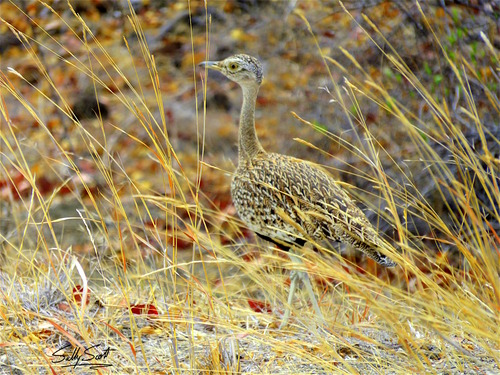
Red-crested Korhaan 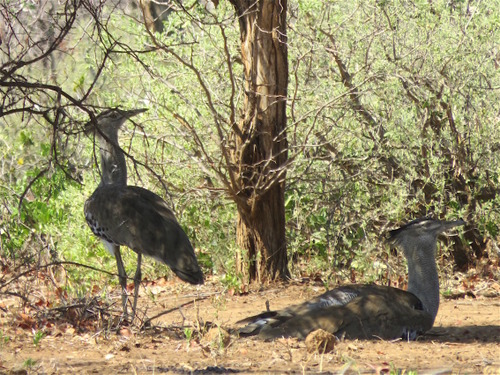
Kori Bustard. 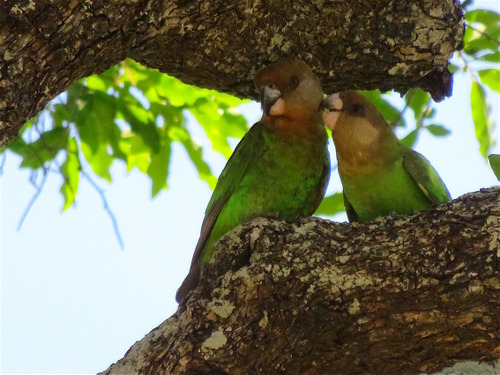
Brown-headed Parrots 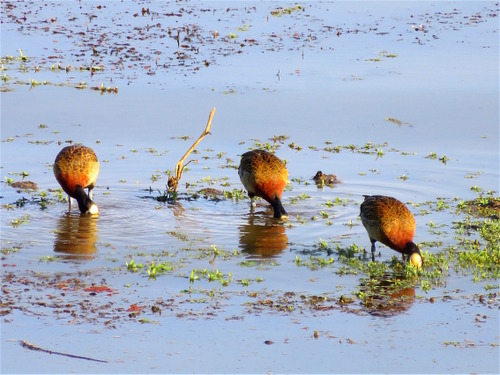
White-faced Duck. 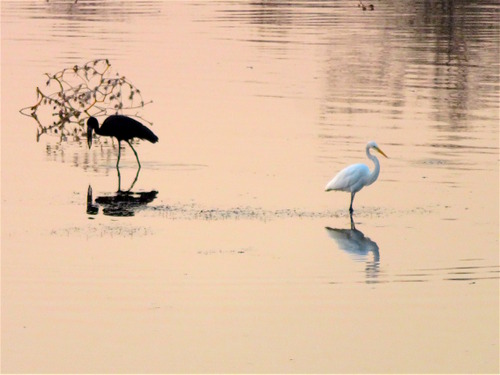
African Openbill and Great Egret 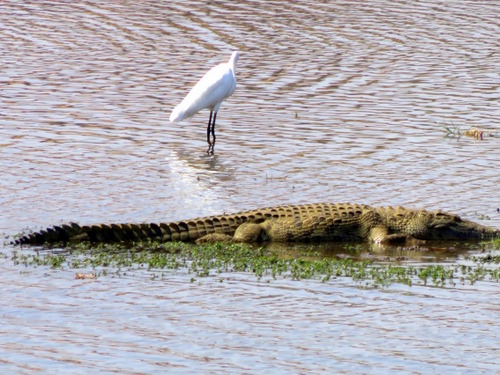
Great Egret, Nile Crocodile. 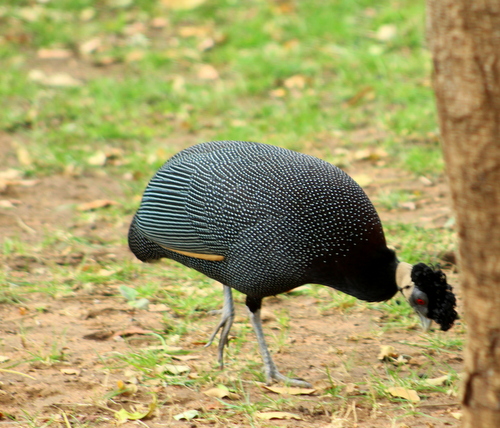
Crested Guineafowl 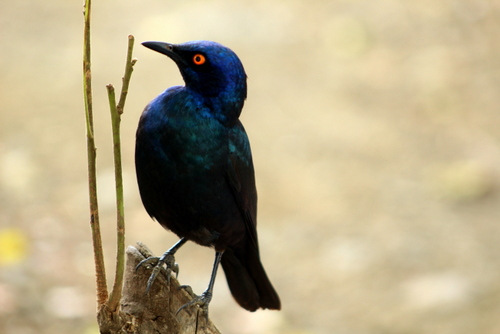
Greater Blue-eared Starling 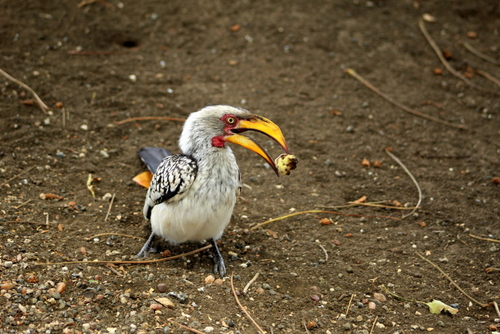
Yellow-billed Hornbill. 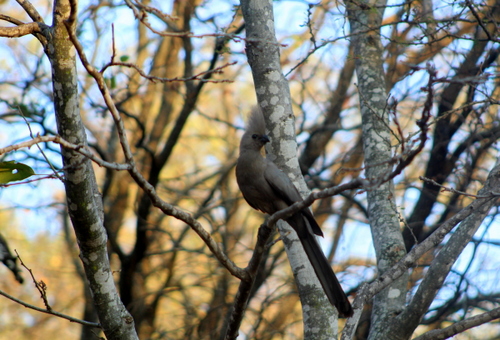
Go-away-bird. 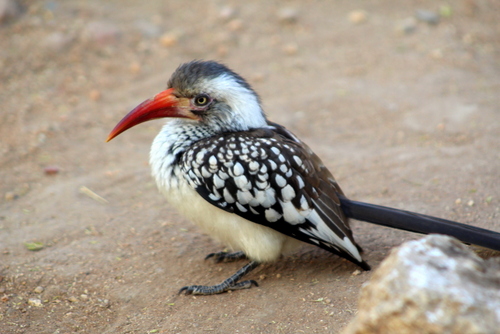
Red-billed Hornbill. 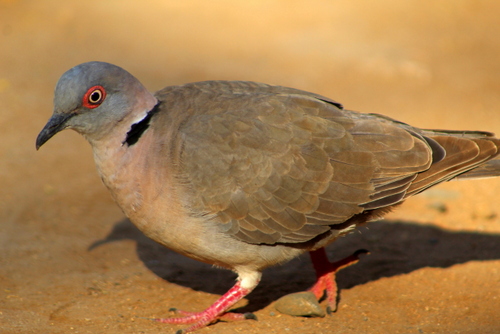
African Mourning Dove 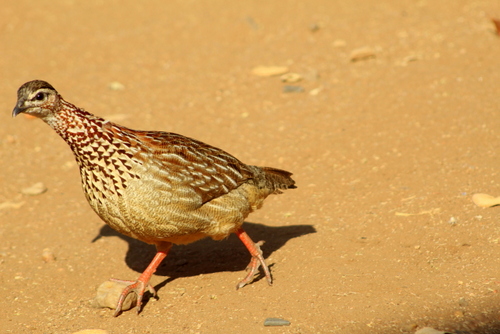
Crested Francolin. 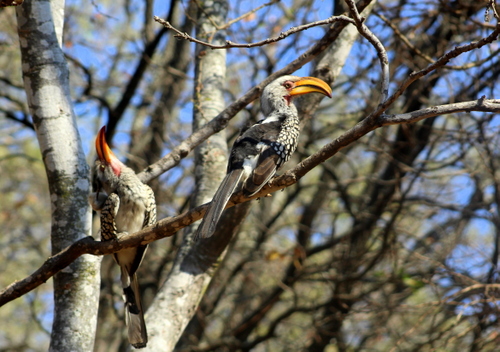
Yellow-billed Hornbill. 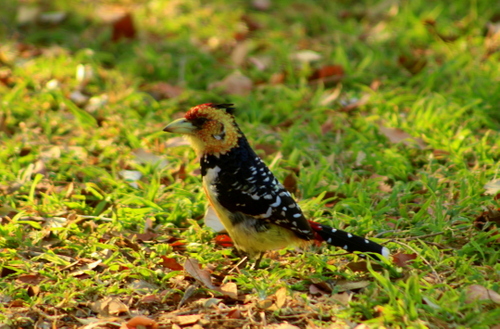
Crested Barbet. 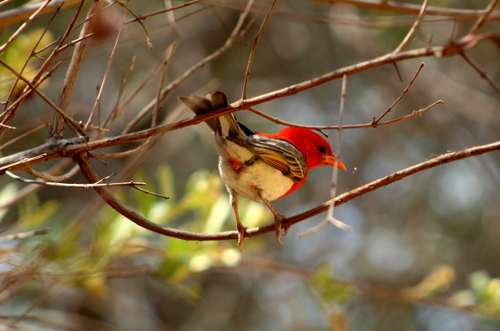
Red-headed Weaver
What a wonderful trip Ant. Wish I’d been with you. Superb photos Love Pat
LikeLike
I wish you could have been too, Pat. As you will have noticed some of the best photos were taken by Sally, using her tiny little camera!
LikeLike